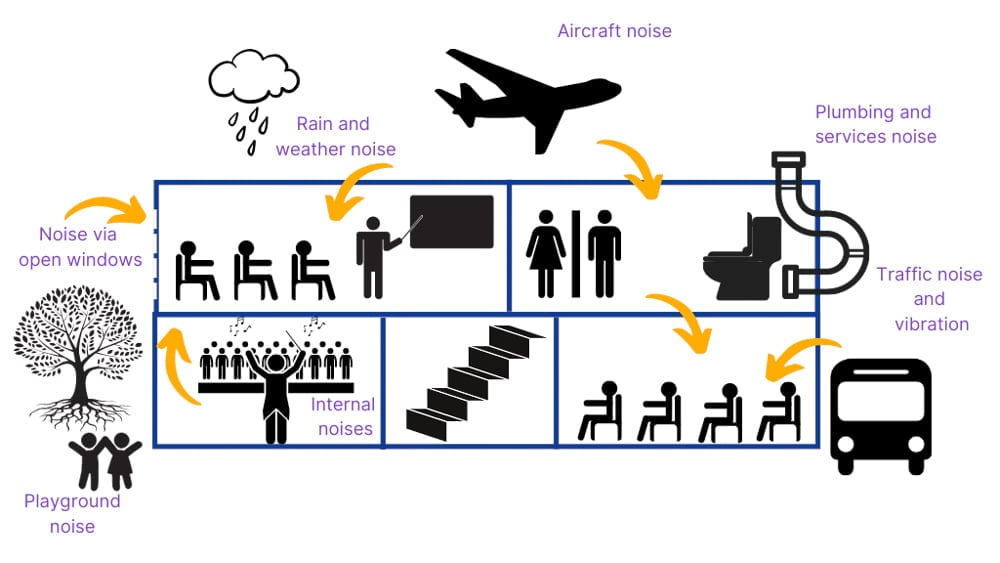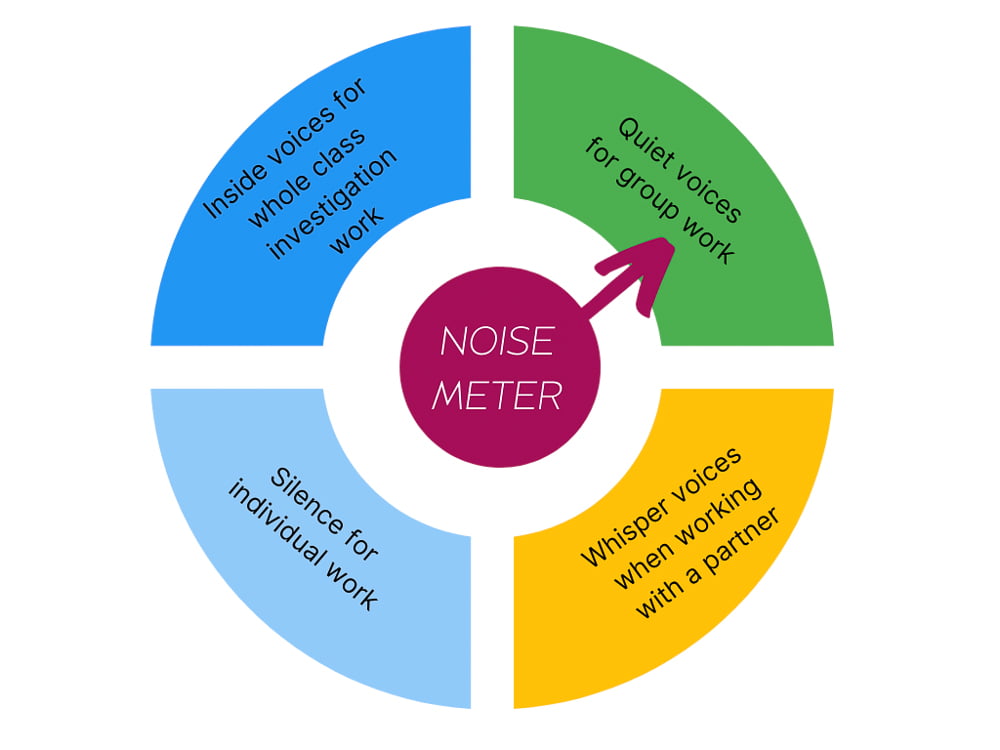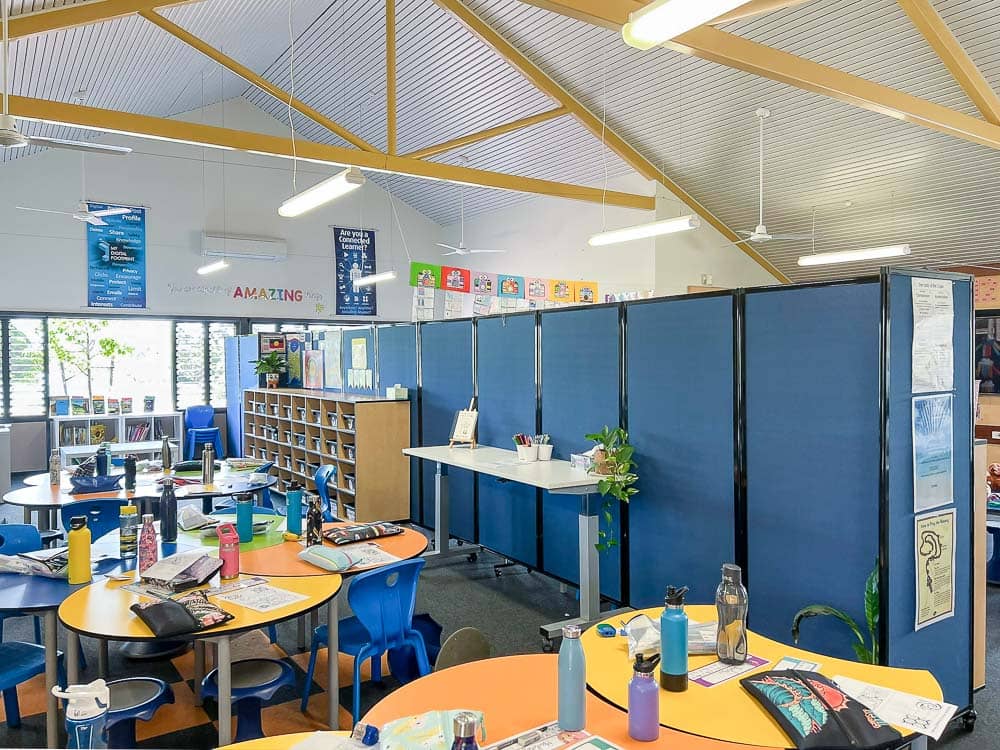Classroom Acoustics: The Complete Guide
The term, ‘classroom acoustics’ refers to the way sound ‘behaves’ within a learning environment: either being absorbed by elements in the space, or reverberating and even amplifying as it bounces off hard surfaces.
Today, we’ll be exploring the effects of classroom acoustics on your students, and how excessive classroom noise can impact academic performance. We’ll also show you how to minimise noise in the classroom, and reveal ways to reduce reverberation so that your students can work comfortably and productively throughout the day.

Table of Contents
The Complete Guide to Classroom Acoustics
- Classroom Acoustics Insights
- The Effects of Poor Classroom Acoustics
2.1 Special Considerations for Diverse Needs in the Classroom - Classroom Acoustics Standards in Australia
- Acoustic Performance: Factors to Consider
- How ‘Listener-Friendly’ is Your Classroom?
5.1 Internal Noise and Reverberation
5.2 Background Noise - Classroom Acoustics Checklist
6.1 Characteristics of Good Acoustic Design - How to Monitor Noise in Classroom Environments
7.1 Noise Thermometer for Classrooms
7.2 Noise Monitoring Apps - How to Improve Classroom Acoustics
8.1 How to Minimise Noise in the Classroom
8.2 How to Absorb Noise in a Classroom
8.3 How Behavioural Changes can Manage Noise Distractions in the Classroom - Additional Resources on Classroom Acoustics
The Effects of Poor Classroom Acoustics
Poor classroom acoustics can take a heavy toll on a student’s ability to work effectively. Too much noise in the classroom can impact their ability to hear and comprehend what’s being said, restricting how much students absorb in class.
This issue is particularly prominent in younger children. With a less mature auditory system, as well as a less developed understanding of language, younger students need a better acoustical environment than adults in order to understand speech. As a result, younger students are more prone to noise distraction in the classroom, and tend to perform more poorly than adults when confronted with a loud environment.
Working in a space with poor acoustics also forces students to expend more energy blocking out disruptive sounds, leaving students with very little cognitive energy left over to focus and learn.

Reverberation and noise in the classroom can severely impact student performance in a range of different ways:
- Speech reception and perception
- Reading and language comprehension
- Spelling
- Linguistic and sociolinguistic patterns and processes
- Cognitive development and processing
- Focus
- Motivation to achieve
- Language development
- Scores in standardized tests
- Teacher-student relationships
- Stress
- Social integration
- Annoyance at other students
- Difficulty hearing and understanding the teacher
Excess classroom noise also forces teachers to raise their voice during class, potentially leading to stress and fatigue. With many teachers complaining of vocal strain and health concerns due to the need to speak at higher vocal levels, poor classroom design and poor classroom acoustics not only impacts a student’s ability to learn, but also the teacher’s ability to teach.
Special Considerations for Diverse Needs in the Classroom
We’ve already explored how noise in the classroom can negatively impact student results, cognitive development, and overall comprehension, but this effect is amplified in children with specific learning requirements.
Children with language disabilities, hearing conditions, and those on the autism spectrum – as well as children who are learning in a language other than their first language – can find a noisy classroom environment to be an even greater obstacle to learning. This is particularly relevant in Australian classrooms where there are a high number of Aboriginal and Torres Strait Islander children who often come from diverse linguistic and cultural backgrounds. Research has found that Indigeouns Australians between the ages of 0-14 are also twice as likely to have a long-term ear or hearing problem, and are three times more likely to have otitis media (inflammation or infection in the middle ear) which can impact hearing.
To create a fair and equitable learning environment for all, it’s vital that you be able to improve the acoustic quality of the classroom to ensure that children of all needs and abilities are able to hear, focus, and learn effectively.
Classroom Acoustics Standards in Australia
In Australia, there are currently no legally enforceable standards or regulations that encompass all aspects of acoustical qualities in educational facilities. In fact, while AS/NZ2107-2000 classroom acoustics standards offer recommendations for ambient noise levels and reverberation times in unoccupied classrooms, they provide no recommendations for occupied classrooms at all. Also, there are no differences between high school classroom design and primary classroom design recommendations.
To correct this, the Association of Australasian Acoustical Consultants draws on a range of studies, papers, and the AS/NZ2107-2000 standards to create the Guideline for Educational Facilities Acoustics.
This document recommends that the following acoustical design conditions be satisfied in order to create an optimal learning environment:
- A spoken voice level of at least 15dB above the background noise level throughout the room
- Unoccupied background noise levels of 30-40 dBA
- Overall sound levels no greater than 65-70 dBA
- Reverberation at less than 0.4s in primary teaching spaces
- Reverberation at less than 0.6s in secondary teaching spaces
- Classrooms fitted with sound absorbing materials and at least 40% absorptive treatment on the ceiling
- Speech Transmission Index of greater than 0.6 in open plan teaching and study spaces
For students with special hearing requirements, further acoustical design conditions should also be satisfied, including:
- Reverberation time of 0.4 seconds or less
- Signal to noise ratio of greater than 20 dB
Acoustic Performance: Factors to Consider

When assessing the acoustic quality of your classroom, there are many factors to consider. Causes of noise distraction in the classroom are typically broken up into two main categories:
Internal classroom sound: Sources of internal classroom sound include reverberation, talking, the scraping of chairs, and excessive HVAC noise.
Background noise: This refers to any noise generated outside of the classroom that makes its way into the space. Background noise stems from a range of different sources, including other classrooms, hallways, playgrounds, areas of high activity, and nearby roads.
How ‘Listener-Friendly’ is Your Classroom?

A ‘listener friendly’ classroom is a learning space in which internal and external noise remains below recommended levels. With minimal noise distraction in the classroom, your students should be better equipped to focus on what you’re saying, as well as on their own learning when it’s time for quiet work.
So what are some of the causes of noise making in the classroom?
Internal Noise and Reverberation
Reverberation can amplify classroom sound, turning even a little bit of noise into a dull roar. This can lead to noise distraction in the classroom and cause stress and frustration for students and teachers alike.
Factors that contribute to excessive noise in the classroom include:
- Large, open-plan designs
- Too many exposed hard surfaces
- Poor insulation
- High ceilings
- HVAC noise (e.g. air conditioners or heaters might rattle, hum, whine, or hiss)
Background Noise
Noises stemming from outside the classroom can be just as disruptive as noise inside the classroom, but external noise can often be a lot more difficult to control. External sources of sound include:
- Neighbouring classrooms
- Play areas and sports halls
- Busy corridors
- Nearby roads
- Construction, maintenance, and gardening works
How ‘Listener-Friendly’ is Your Classroom?
There are many factors to consider when it comes to improving classroom acoustics, so it’s important to identify causes of noise making in the classroom before making changes to the space
This classroom acoustics checklist is a great resource for those looking for ways to reduce reverberation and minimise noise in the classroom.
Characteristics of Good Acoustic Design
Good acoustic design focuses on minimising noise distraction in the classroom. Features should aim to control classroom sound while looking for ways to reduce reverberation.
- Lower ceilings
- Well-fitted doors with acoustic seals
- Double or triple-glazed windows
- Movable partitions for a semi-open flexible learning environment (as opposed to an open-plan design)
- Drapes or blinds on the windows
- Soft furnishings, carpet, and fabric dividers
- Quiet HVAC systems (air conditioners, fans, and heaters should be regularly serviced)
- Classrooms situated away from external sources of noise such as roads and playgrounds
- Physical barriers such as walls, shrubs, and trees blocking external sources of noise
- Insulation between classrooms
- Students with special needs or hearing conditions seated closer to the teacher
- Strategically placed plants and other decorations to minimise reverberation
- Furniture fitted with rubber feet to prevent scraping and screeching
- Walls covered with soft decorations and materials
- Teachers speak clearly and project their voice at all times (perhaps with the aid of voice amplification technology)
- Use of visual aids and displays to assist visual learners as well as students with hearing conditions
How to Monitor Noise in Classroom Environments
From external distractions to the excitement of a Friday afternoon, there are many reasons why students make noise in the classroom. While excitement and a bit of chatter at school isn’t always a bad thing, too much noise can be disruptive. To maximimise focus and minimise distraction, it helps to be able to monitor the level of noise in classroom environments.
Thankfully, there are many helpful tools that can help you identify when a ‘little bit’ of noise becomes too much. You can even turn noise reduction into a game by offering opportunities to earn prizes for keeping the noise below a certain level on your monitoring app or noise thermometer for classrooms.

Noise Thermometer for Classrooms
A digital sound level meter is a handheld device with a microphone that can measure the intensity of noise within a room. Suitable for a range of environments, including factories, workshops, offices, and houses, this convenient device can be used as a noise thermometer for classrooms, helping you identify when noise is beginning to creep over recommended levels.
Noise Thermometer for Classrooms
With the rise of smartphones, you don’t even need to rely on expensive or high tech equipment to monitor noise levels in the classroom. There are many noise monitoring apps available for free:
- Too Noisy Starter (available on Android and iPhone)
- Decibel X (available on Android and iPhone)
- Sound Meter & Noise Detector (available on Android and iPhone)
- Bouncy Balls (Makes noise monitoring fun!)
- Zero Noise Classroom (Chrome extension)
- Calm Counter
How to Improve Classroom Acoustics
Improving classroom acoustics may seem like a big task, but there are many small changes you can make that will have a big impact. Below are just some of the things you can do to optimise the acoustics in your classroom to give all students the best chance at academic success.

How to Minimise Noise in the Classroom
The following are just some of the steps you can take to minimise internal and external noise distraction in the classroom:
- Turn noisy air conditioners, heaters, fans, and other HVAC systems down or off during quiet learning.
- Ensure HVAC systems are regularly serviced to minimise clunking, rumbling, whining, and hissing.
- Turn off equipment when it’s not in use
- Install door sweeps and soundproofing rubber on doors and door frames
- Use polycarbonate or fabric screens and partitions to contain or dampen sound
- Put rubber feet on all furniture legs, or purchase furniture that’s set on smooth-rolling castors
- Use noise-monitoring apps or install a noise thermometer in the classroom
- Schedule gardening and maintenance works outside of teaching hours
- Install soft-closing drawers and doors
How to Absorb Noise in a Classroom
Large classrooms with a lot of bare walls and tiled floors can be particularly prone to reverberation. This can amplify sound and cause distraction for students and teachers alike. Here are just some of the ways you can absorb noise in a classroom.
- Install carpet or cover hard floors with a rug
- Strategically place soft furniture, cushions, and other sound dampening objects throughout the classroom
- Cover windows with fabric curtains or drapes
- Use physical barriers such as fabric partitions to break up large, open-plan learning spaces
- Install proper insulation or mount sound-dampening wall and ceiling panels
- Cover bare walls with decorations that naturally absorb sound, such as cork boards, hanging flags, fabric art projects, and even macrame wall hangers
- Decorate the space with plants to reduce reverberation while adding a pop of vibrancy to the room
- Cover desks with fabric or tablecloths
How Behavioural Changes Can Manage Noise Distractions in the Classroom
Beyond the physical design of the room, there are behavioural changes you can make to reduce noise and distraction in the space.
- Offer students the option of using noise-canceling headphones during independent work (this can be particularly beneficial to students on the autism spectrum)
- When speaking or reading, stand in a spot where all students can see your face
- Provide adequate lighting so students can see your face and mouth as you speak (particularly if they’re hard of hearing)
- Project your voice and speak clearly
- Look out for signs of distraction and intermittently call upon students to answer a question, encouraging them to pay attention
- Watch for signs of a student struggling to hear and either speak louder or move the student closer
- Check in with students to make sure they understand your instructions
- Try to minimise how much you walk around while speaking as this can make things difficult for students who are hard of hearing
- Discourage talking during quiet work or while you’re instructing
- Nurture a classroom culture of respect where students are aware of how their behaviour can impact others
- Set up zones using portable screens to separate ‘noisy work’ from ‘quiet work’
- Educate students about special hearing and learning needs, and explain how their actions can help students of all abilities succeed.
Additional Classroom Design Resources
- Improve Classroom Acoustics with Classroom Dividers
- Classroom Design – Australia’s Ultimate Guide – PPA






